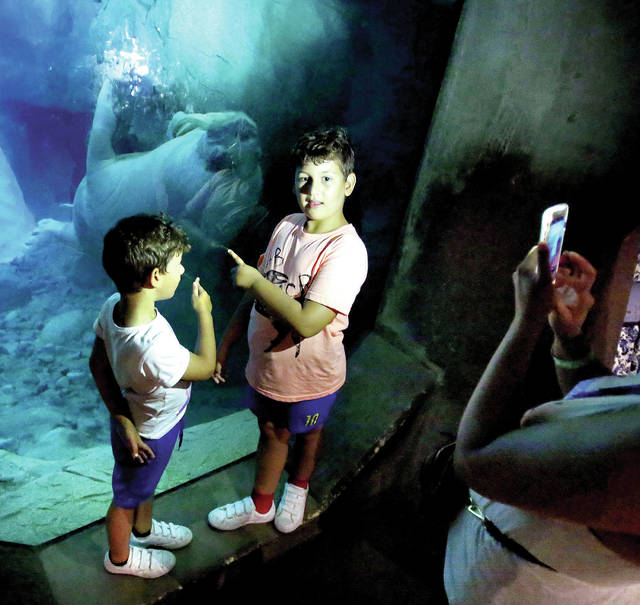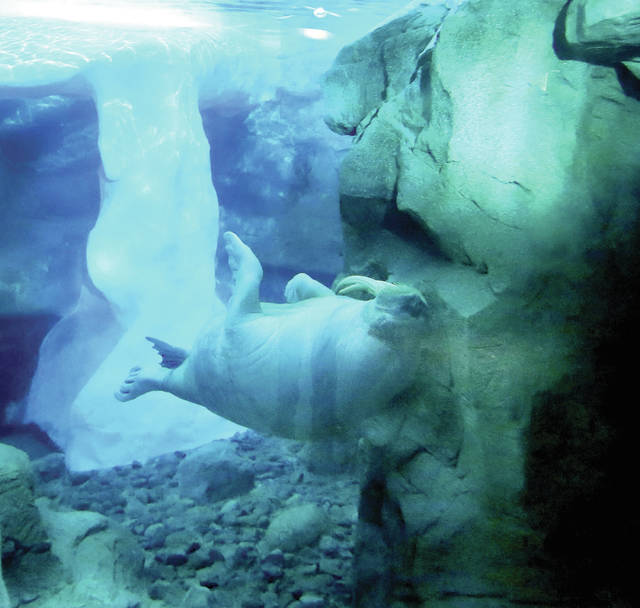SeaWorld Orlando tour offers close encounter with walruses

Young guests view one of the SeaWorld Orlando walrus at the Wild Arctic habitat as a part of the Walrus Up-Close Tour, photographed Sept. 4, 2018. (Joe Burbank/Orlando Sentinel/TNS)

One of the SeaWorld Orlando walrus at the Wild Arctic habitat as a part of the Walrus Up-Close Tour, photographed Sept. 4, 2018. (Joe Burbank/Orlando Sentinel/TNS)
ORLANDO, Fla. — Our Walrus Up-Close Tour at SeaWorld Orlando was almost the experience that wasn’t.
ORLANDO, Fla. — Our Walrus Up-Close Tour at SeaWorld Orlando was almost the experience that wasn’t.
After beginning the tour on an overcast August afternoon — my group got as far as the kitchen, where we learned oodles about feeding the animals at Wild Arctic — and then my group was disappointed to find out that thunderstorms prevented the experience from going further.
ADVERTISING
SeaWorld offered a tour later in the day for those of us who could attend. (If a SeaWorld Tour is canceled, guests can get a refund or select another tour date/time.) After rushing across the park to get to Wild Arctic by 3 p.m., I learned that the words “Code Purple” meant “Game Over” for tours — the words indicate that thunderstorms, and particularly lightning, are in the area and SeaWorld staff are not allowed outdoors.
But my walrus tour was kismet, and in September, I finally got my chance to interact with the massive pinnipeds.
“The Walrus Up-Close Tour offers a unique encounter with one of the most astonishing marine mammals on the planet along with fun facts and timely information on how to protect not only walruses but other Arctic animals as well,” said John DeLuca, leader of SeaWorld’s Education Department.
My first tour wasn’t a complete success, but since Code Purple trapped us indoors, my group did get an in-depth look at the walruses’ feeding and enrichment.
At the Wild Arctic kitchen, Spencer Aldridge, an instructor in SeaWorld Orlando’s animal programs department, as well as Lauren Fletcher and Kelly Trotto, senior keepers at SeaWorld Orlando, gave us the lowdown on the four walruses in Wild Arctic: Garfield (male), Kaboodle (female), Ginger (female) and AKU (male). Garfield and Kaboodle are a mated pair — Trotto said Garfield and Kaboodle had “a special connection right out of the gate” — that gave birth to Ginger, while AKU is a rescued orphan from Alaska. There is a fifth walrus at SeaWorld Orlando, but Slowpoke (a female) resides at the Sea Lion and Otter Stadium.
Aldridge explained that about 420 pounds of seafood are used every day at Wild Arctic. Fletcher, who has a heavy hand in feeding the walruses, said the kitchen goes beyond the United States Department of Agriculture, or USDA, rating to meet Association of Zoos and Aquariums, or AZA, ratings, which means higher quality air, food and training for animals. For example, she said, thawed fish must be used within 24 hours.
The walruses’ diet consists of clams, herring, capelin and squid — though if you try to feed Kaboodle squid, she’ll spit it right back at you, Trotto said.
Aldridge wasn’t around for my second tour, but Angela Casagrande, an instructor in SeaWorld Orlando’s animal programs department, served as my tour guide.
She led me to an outdoor area behind the walruses’ enclosure, where these pinnipeds are taken for enrichment, animal husbandry and sunbathing. It consists of two roofless rooms. The larger of the two gated rooms has a bigger pool, and the smaller has a wading area that can be drained free of water.
There, familiar faces greeted me: Fletcher and Trotto.
I waited outside a gate as Fletcher collected Kaboodle and brought her into the larger room.
My first reaction: This is one enormous female.
Fletcher explained that walruses at SeaWorld Orlando are taught to participate in animal husbandry, demonstrating how Kaboodle flares her nostrils so her nasal passages can be checked and shows her tusks for inspection.
Kaboodle and I got to know each other a little better during feeding time. As I fed Kaboodle, Fletcher said the walrus used her vibrissae (the long stiff hairs growing around her mouth) to touch my hand to gain more information about me. And I gained some insight about Kaboodle when I fed her: She doesn’t like ice cubes.
Kaboodle had to work off some of her fishy treats by demonstrating behaviors. I held out a basketball and a piece of plastic; she chose the plastic. Fletcher asked Kaboodle to return it, and she obliged.
I then held out the basketball for Kaboodle; I asked her to take it and bring it to Trotto by pointing. Using a sucking motion with her mouth, she held onto the ball and brought it, eventually, to Trotto.
Before the tour ended, I got to see the baby walruses at play from a viewing room that overlooked what was formerly the polar bear room. Ginger and AKU splashed around in a small pool until two keepers entered the room for enrichment. I watched as the two were rewarded for correctly demonstrating behaviors. Fletcher said AKU is a fast learner that focuses on food, while Ginger gets distracted and must greet everyone in her environment before she can concentrate.
SeaWorld is working to baby-proof the walrus exhibit so the public can view Ginger and AKU.
The Walrus Up-Close Tour accommodates up to 12 people and runs daily. The price starts at $30, but varies depending on the season and day of the week; kids under age 3 are free. (Note: Park admission must be purchased separately). Personal items, including phones and cameras, are locked up at the start of this experience, so a SeaWorld photographer is on hand to capture memorable moments.
For more information or to book a reservation, call 407-545-5550 or visit SeaWorld’s website.


